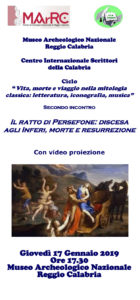The rape of Persephone: descent to the underworld, death and resurrection
Appointment to the MArRC, on Thursday, January 17th, at 17.30, in the Conference Room, in collaboration with the International Center of Writers of Calabria. For the cycle “Life, death and journey in classical mythology: literature, iconography, music”, the philologist Paola Radici Colace, ordinary professor at the University of Messina, honorary president and director of the Scientific Committee of the CIS, held a meeting on the theme “The rape of Persephone: descent into the underworld, death and resurrection”.
The conference will be accompanied by a video projection.
Speakers: the director of MArRC, Carmelo Malacrino, and the president of CIS, Loreley Rosita Borruto.
The title of the meeting focuses on a not much deepened in literature thematic aspect of the myth: Persephone as the “divinity of the limit”, a connecting figure between life and death. Her abduction by Hades is being considered as a travel experience in the afterlife and back to life.
“The themes of the myth resist over time because they answer to the basic questions of man”, Radici Colace explains. “The Olympic religion of the twelve gods offered no hope to human beings after death, because it lacked a theology of salvation. The anguishing prospect was to plunge like pale shadows into the Underworld and wander unhappy in a dimension that resembled the Hell described by Dante”. Around the seventh century BC, the cultural atmosphere changed by the establishment of the mystery cults and the cult of Demeter and Persephone among them. “Up to that time, there was a unique and distinct distinction between human beings and gods: the first were mortals, immortal deities”. So, “for the first time, a flame of light comes on the Underworld – the philologist says -. Persephone is the young woman who has crossed the border between life and death twice and ignites hope on the mystery of the post-death, giving an eschatological answer to the question: “what is the end of men after death?”. The goddess becomes a woman by abduction into Hades, but she has returned to live for six months a year. As in the natural cycle of plants, life is affirmed on death: such as the seed dies in the earth to be reborn in another form, so we can return from death to new life. That is an anticipation of the Christian concept of resurrection”.

